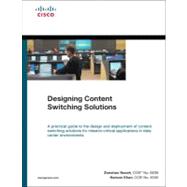
Zeeshan Naseh , CCIE (#6838), is a Technical Leader in Cisco's Advanced Technologies Services Group, focusing on content switching and data centers. He has designed content switching environments for major Cisco Enterprise and Service Provider customers.
Haroon Khan, CCIE No. 4530, is a network design consultant in the Cisco Advanced Technologies Services Group, focusing on content switching, security, and data center design. He has helped design content switching environments for major Cisco Enterprise and Service Provider customers .
| Foreword | |
| Introduction | |
| Server Load Balancing (SLB) | |
| Introduction to Server Load Balancing | |
| Why Load Balance? | |
| Scalability | |
| Availability and Redundancy | |
| Security | |
| Cost Effectiveness | |
| History of Server Load Balancing | |
| First-Generation Load Balancers | |
| Second-Generation Load Balancers | |
| Third-Generation Load Balancers | |
| Characterization of the Application | |
| Protocol and Port | |
| Sessions per Second | |
| Duration of Transaction | |
| Concurrent Sessions | |
| Idle Timeout | |
| Back End Sessions | |
| Session Stickiness | |
| SLB and SLB Modes | |
| Dispatch Mode | |
| Directed Mode | |
| SLB Designs | |
| Layer 2 Design | |
| Layer 3 Design | |
| One-Armed Design | |
| Direct Server Return | |
| Deciding on a Load Balancer | |
| Review of Infrastructure Design Concepts | |
| VLANs | |
| STP | |
| Dot1Q Trunking | |
| Dual Homed Servers | |
| Summary | |
| Introduction to the Cisco Content Services Switch | |
| CSS 11500 Platforms Overview | |
| CSS 11501 | |
| CSS 11503 | |
| CSS 11506 | |
| CSS 11500 Architecture | |
| Distributed Architecture | |
| CSS 11500 Modules | |
| Switch Control Module for the Cisco 11500 | |
| SSL Module for the Cisco 11500 | |
| I/O Modules for the Cisco 11500 | |
| Session Accelerator Module for the Cisco 11500 | |
| Load Balancing with CSS 11500 | |
| Services, Owners, and Content Rules | |
| CSS 11500 Flow Overview | |
| Web | |
| NS Software Features | |
| Infrastructure-Level Features | |
| Load-Balancing Algorithms | |
| High Availability | |
| SSL Integration for Security and Performance | |
| Local and Global Load Balancing | |
| Site and System Security | |
| Summary of Web | |
| NS Features | |
| Case Study: CSS-Based Solution | |
| Server and Application Requirements | |
| Management and Security Requirements | |
| Infrastructure Requirements | |
| Design Options | |
| Traffic Flow | |
| Test and Verification | |
| Summary | |
| Introduction to the Cisco Content Switching Module | |
| Benefits of the Content Switch Module | |
| CSM Architecture | |
| Load Balancing with Content Switching Module | |
| Real Server, Virtual Server, SLB Policy, and More | |
| Load Balancing Methods | |
| VLAN Tag | |
| Client Group (Access Control List) | |
| IP Protocol Support | |
| High Availability | |
| Connection Redundancy | |
| User Session Persistence | |
| A Typical CSM Traffic Flow | |
| Routing with CSM | |
| CSM Network Integration Options | |
| CSM Layer 2 Design Bridged Mode | |
| CSM Layer 3 Design I Routed Mode with MSFC on the Client Side | |
| CSM Layer 3 Design II Routed Mode with MSFC on the Server Side | |
| CSM Layer 3 Design III One-Armed CSM Design | |
| CSM Layer 3 Design IV Direct Server Return | |
| Case Study: CSM-Based Solution | |
| Server and Application Requirements | |
| Management and Security Requirements | |
| Infrastructure Requirements | |
| Design Options | |
| Traffic Flow | |
| Test and Verification | |
| Summary | |
| Layer 7 Load Balancing and Content Customization | |
| Benefits of Layer 7 Load Balancing | |
| Scalability and Application Acceleration | |
| Session Persistence | |
| Content Customization | |
| Introduction to TCP | |
| Data Segments | |
| TCP Headers | |
| TCP Connection Establishment and Termination | |
| TCP Flow Control | |
| Introduction to HTTP | |
| Protocol Details | |
| HTTP Header Fields | |
| Differences Between HTTP Versions 1.0 and 1.1 | |
| Layer 7 Load Balancing Mechanisms | |
| HTTP Methods-Based Load Balancing | |
| HTTP URL-Based Load Balancing | |
| HTTP Cookie-Based Load Balancing | |
| HTTP Cookie Passive-Based Persistence | |
| HTTP Cookie Learn-Based Persistence | |
| HTTP Cookie Insert-Based Persistence | |
| Case Study: Layer 7-Based Solution | |
| Server and Applica | |
| Table of Contents provided by Publisher. All Rights Reserved. |
The New copy of this book will include any supplemental materials advertised. Please check the title of the book to determine if it should include any access cards, study guides, lab manuals, CDs, etc.
The Used, Rental and eBook copies of this book are not guaranteed to include any supplemental materials. Typically, only the book itself is included. This is true even if the title states it includes any access cards, study guides, lab manuals, CDs, etc.